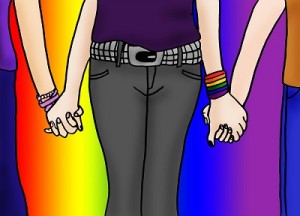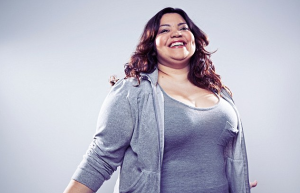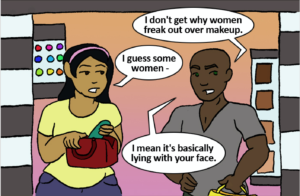I was young when I came to discover masturbation, and I had orgasms long before I knew what they were.
Nothing about it seemed complicated. I just rubbed “down there” for a few minutes, and it happened. But later, magazines, comedy routines, and sitcoms taught me that my body – and vaginas in general – were mysterious and complex, often too complex for those without them to figure out.
Confirming what I’d been taught, orgasms weren’t as simple with partners as they were by myself. This is to be expected to some extent. There’s a learning curve when you’re getting to know someone new. But what confused me was that not everyone seemed eager to learn.
“Sorry,” I (unnecessarily) apologized to a partner for taking what I thought was too long.
“It’s okay. I know it’s harder for girls,” he said – and then stopped.
Compounding the lack of effort I encountered from some (though not all) partners, it became harder for me to orgasm when I started SSRI antidepressants. When I told my doctor, she said, “Oh, that’s hard for a lot of women anyway.”
I knew my body long and well enough to know being a woman wasn’t to blame, but others didn’t share my view that the problem was fixable. I grew hesitant to bring it up with partners out of fear that asking them to perform the supposedly impossible feat of getting a woman off was too demanding.
Orgasm doesn’t have to be the focus of sex, but if a woman wants one, she should have as much of a right to request it as anyone else does.
When people say that women’s bodies are more difficult – and these generalizations typically refer to cis women and are accompanied by rants about how complicated vaginas are – they teach cis women that an orgasm is too tall an order.
Trans women also have a slew of sexual stigmas attached to them, which Kai Cheng Thom describes here, though they’re beyond the scope of this article. In addition, though most research on orgasm inequity has studied cis women, trans and non-binary people with vaginas may relate to the frustrations of being taught their genitals are impossible to decode, too.
The view that cis women are hard to please maintains what sociologists call the orgasm gap, in which men have three orgasms for every one a woman enjoys, and 57% of women orgasm during all or most of their sexual encounters, but 95% say their partners do.
These statistics may appear to confirm the stereotype that women’s bodies are more complicated, but there are other forces at work.
As sociologist Lisa Wade points out, the orgasm gap is conditional. Lesbians report orgasming 74.7% of the time, only 10 percentage points lower than gay men. In addition, women take under four minutes on average to masturbate to orgasm.
If these statistics don’t convince you that there’s more to the orgasm gap than biology, here are twelve cultural factors that contribute to it.
1. People Believe Women Are Less Sexual
Women, the story goes, aren’t that into sex.
They may enjoy it, but they do it partially in exchange for validation, commitment, or financial support, popular wisdom says. As long as a woman is getting one of those things, she doesn’t need much out of the sex itself.
To the contrary, a lot of research and lived experiences indicate that women are as capable of wanting and enjoying sex as men.
Until we acknowledge this, we won’t prioritize making sex as enjoyable as possible for women because we’ll believe sexual pleasure isn’t as important to them.
It may not be because women themselves may buy into myths about their gender, neglecting their desires because they’re not supposed to have them. If they do, they and their partners miss out on balanced sexual interactions, not to mention fun.
2. Pornography Privileges Male Pleasure
Most people who have watched porn videos know they typically culminate with a “money shot” in which the man comes, and then the scene ends. Most woman-focused orgasms depicted in porn are merely incidental events on the path to a man’s pleasure.
Additionally, most mainstream porn scenes feel incomplete without blow jobs, while cunnilingus is less common.
All in all, the message is clear: It’s imperative that a man gets off, and if a woman manages to in the process, props to him, but it’s just an added bonus.
3. The Myth of ‘Blue Balls’ Persists
Blue balls, according to Urban Dictionary, is “the excrutiating [sic] pain a man receives when his balls swell to the size of coconuts because of lack of sex, unfinished bjs, and just not cummin when he knows he should.”
The entitlement reflected in this description is characteristic of most uses of the term “blue balls.” While vasocongestion, the accumulation of blood flow to the genitals, can occasionally cause mild pain in people with any genitals, this is not what men are usually referring to when they complain about blue balls. And whether they’re experiencing this or just sexual frustration, it’s never anyone else’s duty to relieve it.
Even though most women know no medical condition results from an erection that doesn’t lead to an orgasm, many of us feel guilty for not providing one. So, in addition to some men’s lack of effort to pleasure women, the pressure many women feel to pleasure men maintains the orgasm gap.
4. There’s More Information in the Media About Pleasing Cis Men Than Women
As a teenager, my secret guilty pleasure was buying copies of Cosmo from the drugstore and hiding them under my pillow to read at night.
I read all their sex articles just because I found anything sex-related titillating, but along the way, I learned all about different tricks to please men – and cis men, specifically. By the time I encountered a real-life penis, I already knew all the basic tricks in the book, plus some out-there ones my dude friends urged me not to try.
I don’t know what most teenage boys’ secret reading material was, but there aren’t many mainstream men’s magazines as obsessed with pleasing women as women’s are with pleasing men. If anything, I’ve heard it’s common for boys to sneak glimpses of Playboy, which is also geared toward pleasing men.
Maybe this explains why 25% of men and 30% of women can’t locate the clitoris on a diagram.
Amid all the advice we read about different ways to hold and touch a penis, many remain in the dark about vulvas and vaginas.
5. Hookup Culture Privileges Male Pleasure
“I will do everything in my power to, like whoever I’m with, to get [him] off,” one woman said in a study by Elizabeth Armstrong on college hookups. But when it came to their own pleasure, women held different expectations.
“The guy kind of expects to get off, while the girl doesn’t expect anything,” a woman in another study by Lisa Wade said.
Accordingly, one man in Armstrong’s study boasted, “I’m all about making her orgasm,” but when asked to clarify the word “her,” he added, “Girlfriend her. In a hookup her, I don’t give a shit.” Perhaps he sensed that women don’t expect much from their hookups.
Statistics about women’s orgasms reflect these attitudes.
The ratio of men’s and women’s orgasms is 3.1:1 for first-time hookups, but only 1.25:1 for relationships.
For whatever reason, hookup culture appears to have embraced the message espoused by the media that women’s orgasms are optional, while men’s are obligatory.
6. Sex Education Doesn’t Teach Us About Pleasure, Especially Female Pleasure
Like many schools in the US, mine only had a couple of days a year dedicated to sex education in middle and high school. During the initial classes on puberty, the portion about women was on periods and the portion about men was on erections, ejaculation, and wet dreams.
Already, our bodies were associated with making babies, while boys’ were associated with sexual arousal and pleasure.
Later on, we learned how to use a condom – along with how to complete a very normative sequence of events. You put it on, we were told, and then you have intercourse, and then someone ejaculates, and then you pull out and take it off. Men’s orgasms, but not women’s, were built into our safer sex lesson.
Nobody said “then you stop whenever you feel like it” or “your partner may need you to pull out” (because, contrary to what we see in porn, not every woman is multi-orgasmic and many have a refractory period, so we can’t all comfortably keep going until our partner wants to stop).
This is one sneaky way we learn to prioritize men’s pleasure without ever really learning about pleasure at all.
7. Self-Evaluative Thoughts Can Disrupt Women’s Arousal Process
Due to the emphasis on women’s appearances in mainstream porn and throughout the media, women learn to picture themselves during sex.
“How does my stomach look from this angle,” “Does my face look sexy or silly in this expression,” and “Would it be sexier if I made more noise?” are a few thoughts that have distracted me in the bedroom.
And I don’t think I’m alone: 32% of women say that when they don’t orgasm, it’s often because they’re stuck in their heads or focused on their looks.
Orgasm itself can become a source of performance anxiety.
Because the women’s orgasms are dramatized in porn and the media, with exaggerated moans and calculated facial expressions, some women feel so much pressure that fear of not coming keeps them from coming. This pressure can also lead women to fake orgasms instead of sticking it out for a real one.
Once again, women’s magazines don’t help.
Cosmo even provides a guide on “how to look even hotter naked.” Though “even” implies the reader looks hot already, the pre-bedroom workout routine and self-tanner application tips make it clear we don’t look as hot as we could – and even if we do, the focus is still on our partner’s pleasure, not what we see or feel.
Thoughts about partners’ perceptions place women outside their bodies, looking in, rather than inside them, feeling the sensations the sexual activity is causing. It’s hard to have an orgasm when you’re not even thinking sexual thoughts.
8. Sexual Trauma Can Impede Arousal and Orgasm
It’s extremely common for women to experience sexual trauma within their lifetimes. One out of six women has been the victim of attempted or completed rape.
According to sex therapist Vanessa Marin, this trauma can have lasting effects on one’s sex life.
“Sexual assault can rob your enjoyment of sex and can make any type of intimacy feel scary,” she said. “Some survivors experience feelings of disconnect or dissociation when they’re having sex. Others can easily get triggered by being touched in certain places or in specific ways.”
Marin recommends that survivors seek out therapy or a support group so they don’t have to deal with the effects of their pasts alone.
In the short-term, Marin has written that reminding yourself you’re with your partner, not the person who assaulted you, can quell trauma-related sexual problems. “Of course your brain knows that it’s [them], but this exercise can help the more subconscious parts of your psyche start to relax,” she writes.
Other emotions women disproportionately experience around sex, such as guilt and shame, may also lead to anorgasmia.
9. More Women Than Men Are on Antidepressants
SSRI antidepressants, like Prozac and Zoloft, can cause anorgasmia. This side effect isn’t gender-specific, but antidepressants themselves are.
Between 2001 and 2010, 25% of American women (but only 15% of men) had been prescribed medication for mental health conditions.
This may occur because women are more likely to suffer from anxiety and depression, both frequently treated with SSRIs, the medication class most commonly known to cause anorgasmia. There are many theories as to why, but one possible source of this difference is societal misogyny.
As Ally Boghun writes of her anxiety, “A lot of the stressors that impact me the most are actually stressors put upon women by society to look and act in certain ways.” In addition, women are more likely to seek therapy, since toxic standards of masculinity deter men from discussing their emotions.
This is one case where the orgasm gap may be related to biological differences, but the sources of these differences are still societal.
10. Women Are Discouraged from Asking for What They Want
Women are taught to accommodate others’ wishes and put their own on the back burner, to be pleasant and polite and grateful and not ask for more, whether that’s food, payment, or sexual pleasure.
To bring back Armstrong’s research, one woman said she didn’t have the “right” to request an orgasm and “felt kind of guilty almost, like I felt like I was kind of subjecting [guys] to something they didn’t want to do and I felt bad about it.”
I can relate: I’ve said “sorry” many times for requesting or giving myself the stimulation I wanted, for taking what I thought was too much time, and for receiving pleasure without immediately returning it.
The same fear that keeps women from voicing their opinions in work meetings or negotiating salaries also keeps us from speaking up in bed.
But until we can “lean in” without bumping into hostility, women can’t singlehandedly solve this problem in any domain. It’s also up to our partners, coworkers, and others to make it clear they want to hear and accommodate our wishes.
11. The Normative Definition of Sex Isn’t Optimal for Many Women’s Orgasms
When someone says “sex,” most people think of penis-in-vagina intercourse, even though it means many different things to different people.
For example, some couples may see oral sex as sex. Some may also put oral or manual sex on the same level as penetrative sex, but this is still not the norm.
When someone talks about losing their virginity, for instance, we usually assume they’re talking about the first time they had penis-in-vagina intercourse.
This assumption can be problematic for women who get off more easily through other activities.
In one survey, 20% of women said they seldom or never had orgasms during intercourse. Only 25% said they consistently do. In another, 38% said that when they don’t orgasm, a common obstacle is “not enough clitoral stimulation.”
Since penetrative sex often doesn’t directly stimulate the clitoris, this could explain why other types of sex – or clitoral stimulation during intercourse, which women considered the most common way they got off with a partner – may be more optimal.
When we consider the activities that often help women reach orgasm as warmup or extra, we deprioritize women’s pleasure.
12. People Think the Orgasm Gap Is Biological
Orgasm inequity is a self-fulfilling prophecy.
When men believe women’s bodies are an impossible puzzle, they don’t try to solve it. Neither do women who are taught their own pleasure is inaccessible.
That’s why it’s important we acknowledge all the societal factors that contribute to this discrepancy. Genetics can’t be fixed, but a lot of these problems can, which means that closing the orgasm gap is possible.
***
If you’re a woman having trouble orgasming, it’s likely not you. It may not be the result of any carelessness on your partner’s part either. You may just need to talk about it, challenge the myths you’ve learned about sexuality, and, if necessary, seek help for any psychological or medical conditions that could be contributing to the problem.
Or maybe it’s not a problem at all. Maybe orgasming isn’t important to you, and that’s your choice as well. But if it is something you would like, you have the same right to ask for it as your partner. If he expects orgasms from you, he shouldn’t mind you wanting one.
It’s not too much to ask, and your anatomy isn’t too complicated. The only thing that’s complicated is the toxic set of messages we’re taught about sexuality. But that’s not on you or your body.
[do_widget id=’text-101′]
Suzannah Weiss is a Contributing Writer for Everyday Feminism and a New York-based writer whose work has appeared in The Washington Post, Salon, Seventeen, Buzzfeed, The Huffington Post, Bustle, and more. She holds degrees in Gender and Sexuality Studies, Modern Culture and Media, and Cognitive Neuroscience from Brown University. You can follow her on Twitter @suzannahweiss.
Search our 3000+ articles!
Read our articles about:
Our online racial justice training
Used by hundreds of universities, non-profits, and businesses.
Click to learn more





















